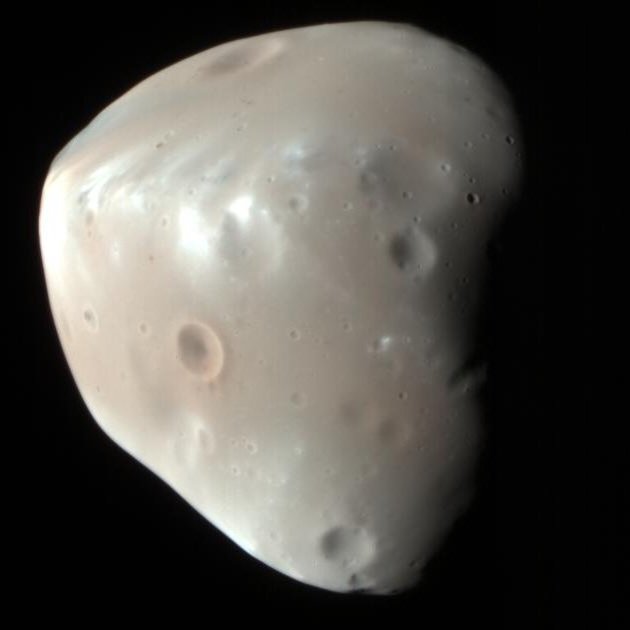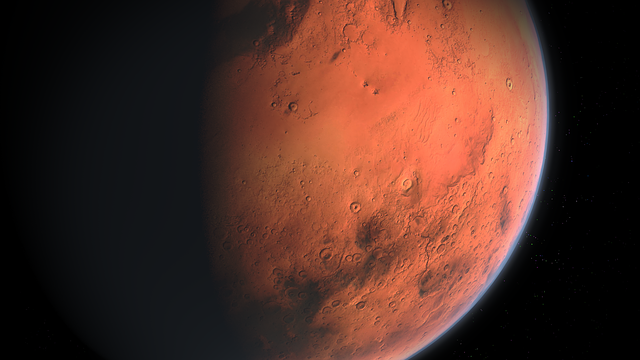*This post may contain affiliate links. This means we may make a commission if you purchase an item using one of our links*
The main differences between Mars and Deimos is that Mars is a planet while Deimos is a natural satellite, Deimos is far smaller with a diameter of 12.4km while Mars has a diameter of 6,779km and Deimos is tidally locked to Mars while Mars is not tidally locked to anything.
For a more detailed look at both Mars and its moon Deimos along with their similarities and differences, continue reading as it will be covered in more detail below.
What Is The Moon Deimos?
Table of Contents

Deimos is the smaller and outermost of the two moons of Mars, named after the Greek God of dread and terror (the brother of Phobos). This satellite was also discovered by American astronomer Asaph Hall just five days before Phobos (12th August 1877).
Scientists like Johannes Kepler had put forward theories for the existence of these moons many years before they were discovered. Their calculations were based on the fact that the planets on either side (Earth and Jupiter) possessed one and four moons, respectively.
Still, none were discovered until the 19th century. One of the main reasons for this is that the tiny size of Phobos and Deimos, combined with an exceptionally close orbit to their planet, means that the glare of Mars often obscures our view of them.
Phobos measures just 15 x 12 x 11 km and completes an orbit of Mars once every 30 hours.
This tiny moon is also a heavily cratered landscape shaped by the impact of asteroid collisions over time. However, the material thrown up from these impacts doesn’t appear to have landed back on the moon’s surface as it usually would. This could be because the lack of gravity on Phobos allowed the ejected material into space.
The surface gravity on Deimos is just 0.003 m/s^2 (compared to 9.807 m/s^2 on Earth), which means the average gravitational pull of Deimos is only 0.003 m/s. With only 1/2500th of Earth’s gravity, you would need a tether to walk on this rocky moon, or every step would put you at risk of achieving escape velocity and launching yourself into space.
The composition of Deimos is similar to Phobos, suggesting that it might also be a captured asteroid. Its surface is very dark gray and has an albedo of around 0.07, meaning it reflects just 7% light (about half of the light Earth’s moon can reflect).
What Is The Planet Mars?

Mars, also known as the red planet, is the celestial object that’s the front runner in our entire solar system to become a possible new home for us if terraformed. It is also the 4th farthest planet from the Sun and is one of 4 main line terrestrial planets (not including Pluto) in our solar system.
This means that one year on Mars will take roughly 687 Earth days and a day on Mars is roughly the same as Earth at 24 hours and 37 minutes. It’s axial tilt is also very similar to that of Earth where it is positioned around 25 degrees to the right.
It may not be the largest terrestrial world in our solar system as its diameter is only 6,779km but, it does have the most moons amongst the normal terrestrial planet where two, namely Deimos and Phobos, are currently orbiting the red planet.
Like Earth and the other terrestrial worlds, Mars does have an atmosphere, certainly more visible than that on Mercury but, when compared to Earth’s it is merely 1% of its volume.
As a result it is more susceptible to larger debris striking its surface and is unable to trap in too much heat either. This is why it’s on the colder side with a temperature of around -65 degrees Celsius on average. On the contrary its core is significantly hotter at 1,350 degrees Celsius.
Mars is probably the most explored planet outside of our own, with a multitude of rovers like Sojourner (1997–1997), Opportunity (2004–2018), Spirit (2004–2010), Curiosity (2012–), and Perseverance (2021–) that have landed on the Martian soil to explore it.
Billionaires like Elon Musk and even Jeff Bezos are trying for an opportunity to genuinely have astronauts land on the Martian soil, possibly as early as 2029 so, Mars clearly has a lot interested in its terrain, as a potential substitute for Earth in the future.
Similarities Between Deimos And Mars
Deimos and Mars do have their odd few similarities, which in this case includes the below:
- Both have a rocky surface.
- Both are a spherical shape.
- Both are part of the same solar system.
- Both have no rings surrounding them.
- Both orbit the Sun in 687 days.
Differences Between Deimos And Mars
As for the differences between the two, they include the below.
- Deimos orbits Mars whilst Mars only orbits the Sun.
- Mars is a spherical shape while Deimos is not.
- Mars has 2 moons orbiting it while Deimos has none.
- Mars is a terrestrial planet whilst Deimos is a terrestrial based natural satellite.
- Mars has a diameter of 6,779km whilst Deimos has a diameter of 12.4km.
- Deimos has no atmosphere whilst Mars has an atmosphere that is 1% of Earth’s thickness composed of 95% carbon dioxide 2.6% nitrogen and 1.9% argon.
- A day on Deimos takes 30 hours whilst a Mars day takes 24 hours and 37 minutes.
- Deimos’ temperature ranges between -4 to -112 degrees Celsius whilst Mars has an average temperature is -65 degrees Celsius.
- Mars’ density is 3.93 g/cm³ whilst Deimos density is 1.47 g/cm³.
- Mars’ mass is 6.39 × 10^23 kg whilst Deimos’ mass is 1.4762 × 10^15 kg.
- Deimos’ gravitational strength is 0.003 m/s² whilst Mars’ is 3.721 m/s².
- Deimos is tidally locked to Mars whilst Mars is is not tidally locked to any entity.
- Mars has some symptoms of volcanic activity while Deimos does not.
- Mars has a hotter central core while Deimos does not.
- Mars has an axial tilt of 25 degrees while Deimos has an axial tilt of 0 degrees.
Summary
Other than occupying the same region and Deimos being one of Mars 2 moons, there isn’t very much that the two have in common.
Whether it be in regards to size, mass, shape, and overall functionality, the two are very much their own easily distinguishable celestial bodies.


